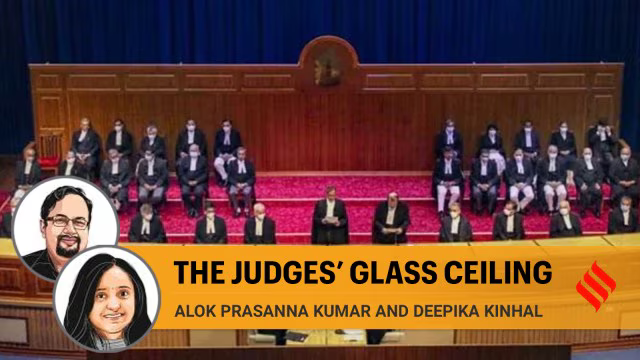
The Constitution Bench Pendency Project: Methodology and Challenges
Cases pending before constitution benches: The need for transparency
Judgments pronounced by constitution benches (i.e. Supreme Court benches with five or more judges) have decidedly shaped Indian history in immeasurable ways. While much has been written about judgments which have been passed or are currently being argued, there is not enough literature about those which have been pending for years. Not only is there a lack of information about the specifics of these cases, there is no authoritative data on the number of cases pending before these benches either.
Information pertaining to these pending constitution benches is often erratically published, with only those cases relevant to news cycles often finding mention. To address this vacuum the JALDI (Justice, Access and Lowering Delays in India) Initiative at Vidhi has introduced the Constitution Bench Pendency Project. A publication of the project is a database on the JALDI portal that hopes to be an one-stop accessible resource, removed from legalese for an audience of law students, legal researchers, journalists and advocates looking for a bird’s-eye view of the pending cases.
The following sections explain the methodology followed to arrive at the database and the challenges faced along the way.
Data collection and cleaning: The challenges
Data collection
The primary custodian of data on the cases pending before the Supreme Court including its constitution benches, is the Supreme Court itself. Unfortunately, however, data from the two different sources that record such pendency related statistics within its own website tell different and incomplete stories. These sources are:
- The monthly statistics tab which has consolidated figures on the number of pending cases. This includes within it, the number of pending constitution bench cases. As deciding a single case can lead to disposing multiple cases that have a similar fact background, these statistics are bifurcated into main and connected matters (tagged matters).
- The terminal cause list provides a more itemised list of the cases including those pending before constitution benches. Unfortunately, however, during the course of our research we found that this cause list fluctuated sporadically without any of the missing cases being heard in court.
On comparing data from these two sources, we found a drastic variance in the numbers. For instance, in January 2022, the monthly statistics identified that 272 five judge matters were pending, while the terminal cause list identified it to be 94. To remedy such dissonance and ensure a fixity in numbers, we filed an RTI application with the Supreme Court. The response received (‘RTI data’) on 8 March, 2021 is the database used by the portal.
Data cleaning
To study these cases, we went through ‘case details’ i.e. orders and the case status pages on the Supreme Court website. While doing so, we found a few more aberrations between the case details and the RTI data, particularly with respect to connected matters. For instance,
- While a case could have been identified as a main matter in the RTI response, it could be considered a connected matter in the Supreme Court website. For instance, while the RTI response identified Jaikant Kumaran v. Manika Jaikant Kumaran as the main matter, the Supreme Court orders identified Shilpa Sailesh v. Varun Sreenivasan to be the main one.
- The number of connected matters between the two varied.
- In many instances, the case status page had insufficient information on orders, case details and dates, particulars of which have been highlighted in the next section.
Recognising that the RTI data set could be improved with inputs from the case details pages, the dataset was updated and modified. To keep the dataset updated, we also eliminated cases which had been disposed of till 1 January, 2022.
Resultantly, we found the following number of matters pending before the constitution benches:
| Bench Strength | Main | Connected | Total |
| 5 Judge | 25 | 267 | 292 |
| 7 Judge | 5 | 57 | 62 |
| 9 Judge | 5 | 228 | 233 |
| Total | 35 | 552 | 587 |
Summary drafting: The challenges
Given the lack of comprehensive data across platforms including the High Court websites which hosted the orders which were appealed, even the process of summarising cases faced peculiar challenges. To provide a better idea of the limitations in the presentation of information on the portal, some of these challenges have been identified below:
- Inaccurate filing dates: For determining how long cases had been pending for, knowledge of the filing date was a pre-condition. However, for some cases such as the Bar Council of India v. Bonnie Foi Law College, 01-01-1900, had incorrectly been identified as the filing date for three connected matters.
- Unavailability of tagging orders and historic data: Post digitisation of the Supreme Court, some historic data such as older orders was not available. In other cases, the orders tagging cases to the main matter were not available. For instance, in Property Owners Association v. State of Maharashtra, the tagging order is available for only one out of the 15 connected matters.
- Cases where judgments have been delivered by constitution benches are incorrectly marked as pending: Such a situation seems to often arise in cases where the Constitution Bench decides issues of interpretation of the Constitution but refers the case back to the original bench for a decision on merits. Therefore, while the case has been decided by the constitution bench, and the question of law has been resolved, marking it as pending before a constitution bench is a misnomer.
- Challenges of identifying the main matter: In peculiar cases like Assam Public Works v. Union of India, it was difficult to ascertain the main matter. Even though both the Supreme Court website and the RTI data classified Assam Public Works as the main matter, the order referring the case to the Constitution Bench was delivered in Assam Sanmilita Mahasangha v. Union of India (the Assam Accord case). Seeing the merits in harmonising the two to get a fuller sense of the controversy, questions from both the cases have been integrated. However, even though we believed that Assam Public Works was not the main matter in the NRC issue, we had to rely on what the Supreme Court was telling us.
- Non-availability of High Court orders: Many of the pending cases arise from appeals of High Court orders, which in turn are not available. For instance, in Union of India v. Preeti Agarwal, the Delhi High Court judgment, which lies at the root of the Constitution Bench case, is not available in the public domain. Further, since most High Court websites require a captcha to access data, providing hyperlinks to orders was not possible. Instead, these orders have been uploaded on the linked Google Drive, as far as possible.
- Inadequate information on court’s reasoning for reference or potential arguments: In some orders, information like the court’s reasoning for referring a matter to a larger Constitution Bench was sparsely available with orders just being a few lines long. Similarly, since enough reasoning could not be culled out on potential arguments in prior orders or referred judgments, only limited reasoning was done.
- Limited further readings: In order to make the resources pertaining to the case more rounded, a section on further reading was added. However, there was a lot of variation in terms of available information. While cases on the issue of Jallikattu or Sabarimala have been written about extensively, certain pending Constitution Bench matters hardly found any mention in mainstream media. Hence, there is some disparity between the number of external readings available for different cases.
Need for better availability of judicial data
We hope that the identified challenges help readers understand the methodological limitations of the research. We also hope that this project furthers the case of lack of availability of good judicial data and inches the needle forward to the goal of democratising legal information and making it more transparent. Eventually, we hope that some of the problems that we have identified in this post will be addressed to allow for more comprehensive research on the subject.



